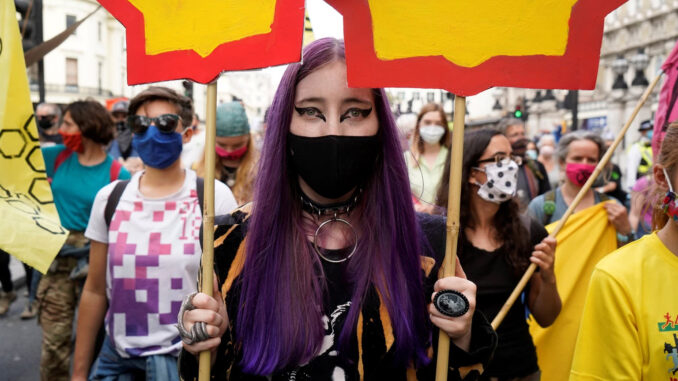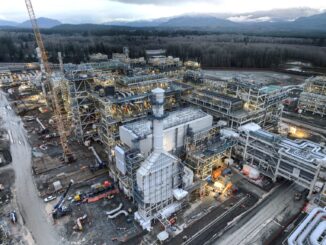
Last week marked a watershed in the oil industry’s reckoning with climate change. The landmark setbacks in the courtroom, boardroom, and shareholder meetings for some of the world’s largest oil firms were stunning victories for climate activists in their battle against Big Oil. Whether these defeats will also be a victory in the battle against climate change, however, is less clear. That will depend on whether growing societal pressure to deal with the climate crisis leads to the policy changes and technological advances needed to rapidly curb oil use, as society must. In a global oil market where supplies are freely traded and the big Western oil firms control only a small share of output, reducing these companies’ production alone won’t be enough. Without simultaneously reducing the demand for oil, it could create heightened economic, political, and geopolitical risks while failing to have as big an impact on emissions as necessary.
It was the “week that shook Big Oil,” as NPR put it. Last Wednesday, a court in the Netherlands ruled that Royal Dutch Shell had a legal obligation—grounded in human rights law—to cut emissions nearly in half by 2030, not only from its own operations but also from the use of the oil and gas it produces by consumers and businesses.
That same day, a largely unknown hedge fund owning a tiny amount of Exxon Mobil stock invoked the “existential risk” of climate change to capture three seats on Exxon Mobil’s board of directors, a staggering defeat for a company of Exxon Mobil’s size. Notably, major institutional investors, such as Blackrock, Vanguard, State Street, and Fidelity, are under mounting pressure from their own investors on climate change—and felt compelled to support at least some of the activist board candidates.
Finally, also on Wednesday, Chevron’s shareholders passed a resolution, over the board’s objection, calling on the oil major to substantially reduce not only its own emissions but also those from the gasoline, diesel, and other products it sells to its customers.
These defeats came right on the heels of another blow. The previous week, a landmark report by the International Energy Agency (IEA)—widely seen as the authoritative source for energy analysis and by no means a radical voice—found that investment in new fossil fuel supply projects would no longer be needed if the world were on track to achieve net-zero emissions by 2050. The headline-grabbing conclusion was a striking departure from the IEA’s warnings just a few years earlier, based on less ambitious decarbonization pathways, that companies risked not investing enough in oil and gas.
As Stanford Law School professor Michael Wara put it responding to last week’s shareholder votes: “Times are changing. Faster and faster.”
The trouble, however, is that times aren’t changing where it matters most. Global greenhouse gas emissions will return this year to levels just shy of their pre-pandemic peak and are projected to keep going up. Long proclaimed in terminal decline, coal use is set to rise this year, nearly to its all-time peak in 2014, and new investment in coal continues. Despite the hits to oil majors last week, oil demand this year will recover two-thirds of the decline due to the pandemic-induced lockdowns. Indeed, demand is currently on course to continue rising in the years to come.
Last week’s victories over Big Oil reflect rising concern about climate change and expectations that companies and policymakers take more urgent action. Many are promising to do so, with more and more countries pledging ever more ambitious carbon reduction targets, as many did at the Leaders Summit on Climate organized by the U.S. government in April. Today, more than 60 percent of countries have some kind of net-zero goal, as do more than 20 percent of the largest 2,000 publicly listed companies.
These pledges, while most welcome, risk further widening the already vast chasm between ambition and reality, however, unless they are matched with concrete actions to curb emissions. So far, those actions are badly lagging. That is why the IEA projects a hypothetical 75 percent decline in oil use by 2050 in a net-zero scenario, but based on policy plans announced to date, it sees actual oil demand continuing to increase for the next two decades.
Despite its headline-making broadside against oil investment, the IEA’s new report offers little comfort. While it is possible—and necessary—for countries to meet their pledges, the IEA reminded us how staggeringly difficult that will be. Consider that achieving net-zero emissions by 2050 would require building the equivalent of the world’s largest solar park every single day for the next three decades. Or that half of the emission reductions between now and 2050 will have to come from technologies not yet commercially available, in particular to decarbonize such sectors as steel, cement, and chemicals. Or that global energy use in 2050 will have to be lower than it is today—even as GDP and the global population grow and energy use rises in parts of the world that use relatively little energy per person today, such as Southeast Asia and Africa.
Perhaps the much-touted new electric version of Ford’s F-150 pickup truck can be the game-changer that brings electric vehicles into the mainstream, but the numbers are still daunting. Global electric car sales in 2020 were around 4 percent of total sales. The number of cars in the world is projected to rise from roughly 1 billion today to 2 billion in 2050—so even if the share of electric car sales rose to 50 percent, the number of cars running on oil would remain roughly flat. Moreover, passenger cars comprise only 25 percent or so of the world’s oil use, and it is much harder to find alternatives for long-haul trucks, ships, and planes.
Emissions only go down if oil use declines or, to a limited extent, emissions are captured or removed, so the impact of last week’s events depends on whether they accelerate the move away from oil. They underscore the need to seek demand reduction through mandates, incentives, investments, and innovation—not just curb supplies—in order to sustain economic growth and political stability in a global economy. The point is not to defend producing more oil and gas—quite the opposite. The key is this: Unless both supply and demand change in tandem, merely curbing the oil majors’ output will either shift production to less accountable producers or have potentially severe consequences on economic and national security interests while doing little to combat the climate crisis.
The defeats for Big Oil could have two effects: First, they will add to the growing stigmatization of the industry, perhaps further reducing its ability to tap public markets for capital. Second, they could potentially cause oil majors to divest assets and curtail their oil output.
On the first point, large financial institutions and asset managers are already under rising pressure to curb investment in oil for environmental, social, and governance reasons, including threats from climate change. The oil industry’s difficulties also reflect its recent poor profitability and growing investor demand to return more money to shareholders. As a result, even though oil prices are rising again, shale oil firms have not been racing to increase output as they did previously by borrowing more. This year, oil production outside of OPEC and its allies (known as OPEC+) is expected to make up less than half of last year’s decline.
The recent IEA net-zero report may add to pressures on banks given the agency’s warnings about new fossil fuel supply investment, even though the report still found that trillions of dollars will have to be invested in existing oil and gas fields (as opposed to new ones). The report was widely understood to warn that “investments in all new fossil-fuel projects must stop now if the global energy sector is to achieve carbon neutrality by 2050,” as the Economist put it. Yet this interpretation confuses causation: The IEA report finds that if the world were on a pathway to achieve net-zero emissions by 2050, no investment in new fossil fuel supply would be needed. It did not say that ceasing new investment will put us on that pathway. Other urgent actions are needed to achieve that goal.
On the second point, even for firms less dependent on tapping capital markets, last week’s courtroom and boardroom actions may still force companies to curb output. If an oil firm is to reduce the emissions from the use of its products, as the court ordered Shell to do and shareholders asked Chevron to do, there are only two ways to achieve that. One option is to capture, remove, or otherwise credibly offset the emissions, and the other is to produce and sell less oil. The court-ordered target for Shell is so large and fast—a 45 percent reduction by 2030—that it is hard to see the company achieving it without divesting some of its oil assets and producing less. Exxon and Chevron will be under pressure to do the same.
Reduced investment and production by the oil majors will, in turn, have several implications for the climate, economy, and geopolitics.
To some extent, until oil demand starts falling, production will simply shift to other producers, which would not reduce emissions and may have other unintended consequences. Consider that while the global majors—including Shell, Chevron, Exxon, BP, and Total—attract the most attention, they only produce 15 percent of the world’s oil and gas supply. Most oil and gas is produced by state-controlled companies that are much less responsive to activist pressure and less dependent on financing from financial institutions that are. If oil production shifts to national firms in the world’s leading petrostates, that would increase the share of global supply controlled by OPEC+ and increase the cartel’s control of world oil markets. Indeed, Saudi Aramco, Abu Dhabi National Oil Company, and Russia’s Rosneft are all investing large sums today to increase oil production, motivated not just by a desire to monetize the oil before the world no longer needs it, but even more by a belief that demand for their oil will rise as Western firms are pressured to curb investment. Ironically, almost half of investors in a recent survey said oil companies were good investments because they would benefit from another oil price boom before decarbonization becomes an issue.
Moreover, to the extent the oil majors respond to shareholder and legal pressures by selling their fields, others can buy those assets and still produce the oil, as recent experience suggests is likely. That is partly why private equity companies have shown increased interest in oil and gas production in recent years, as poor performance and climate concerns caused publicly listed oil companies to turn their back on some mature fields. In the British North Sea, for example, oil majors have been selling many of their fields to private-equity-owned groups. Private equity now accounts for 10 percent of all North Sea oil production, up from virtually zero in 2014. To the extent capital from Western banks dries up, Chinese banks have also demonstrated they can fill the gap.
At the same time, oil output and investment by Big Oil may not be completely offset by others. In that case, markets will tighten if supply constricts more quickly than demand, which will have at least three effects.
First, tighter oil markets mean higher prices. On the one hand, higher prices can accelerate the clean energy transition by encouraging conservation and making alternatives to gasoline cars, such as electric vehicles, trains, and mass transit, more economically attractive. Indeed, environmentalists suing Shell relied on that very argument, and the court cited analysis to that effect in rejecting Shell’s defense. On the other hand, high oil prices hurt consumers at the pump and slow the economies of oil-importing countries. Moreover, high gasoline prices risk causing a backlash against stronger climate policies, as France’s “yellow vest” protests against rising green taxes on fuel demonstrated. Indeed, Europe’s current plan to extend its carbon pricing regime to more sectors of the economy is already drawing fierce political blowback. Yet at least with a carbon price policy, government could, if it wished, offset the impact on consumers by returning the generated revenue to people. That is not an option when the price hikes result from market forces themselves and the increased spending by consumers flows to petrostates.
Second, tighter oil markets and higher prices will boost the geopolitical leverage of OPEC+ nations. Above all, they will strengthen the position of Saudi Arabia, which is the only nation that maintains significant spare output capacity so it can quickly put additional barrels on the market when needed. The Biden administration may be no fan of oil firms, but few politicians welcome higher pump prices, as the administration demonstrated by putting out a press release defending against higher prices in advance of Memorial Day weekend, when many Americans take to the road. If investors turn their backs on the oil sector even as oil demand rises, oil prices could easily spike. Republicans would surely attack President Joe Biden for causing those higher pump prices with his policy choices, such as banning new oil and gas leasing on public lands. Even if those attacks are meritless, they could nonetheless affect election outcomes. Policymakers have few options to curb high gasoline prices in the short term other than to call on those nations that can boost output to do so, as both Republican and Democratic presidents have done with Saudi Arabia in the past. At a time when the Biden administration may be seeking to confront the kingdom over such issues as human rights or the war in Yemen, the ability to keep oil prices in check will boost Saudi Arabia’s leverage.
Third, tighter oil markets will exacerbate energy security risks by reducing the ability to handle unexpected disruptions. The recent cyberattack on the Colonial Pipeline, the Texas deep freeze that shut down oil and gas wells this winter, and current tensions in the Middle East and South China Sea are stark reminders of the many risks related to weather, cybersecurity, and geopolitics that threaten the oil and gas supply. In tighter markets, these risks will loom even larger. Consider the 2019 attack on Abqaiq, the world’s largest oil-processing facility, in Saudi Arabia. Markets largely shrugged off the sudden loss of more than 5 percent of the global oil supply, but the impact on gasoline supplies and pump prices would have been far more severe if the oil market hadn’t had as much slack as it did, with extra supply stocks at unusually high levels at the time.



